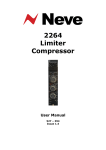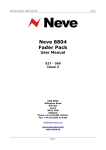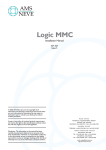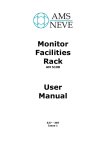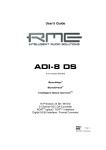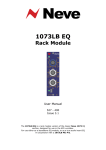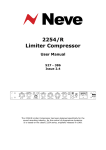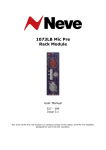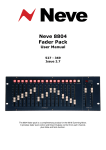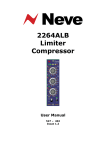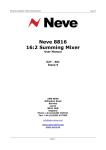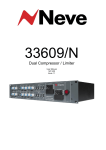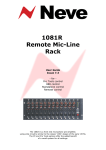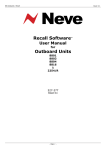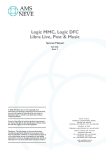Download TDIF/MADI Interface
Transcript
TDIF/MADI Interface User Guide 527-185 Issue 4 HEAD OFFICE AMS NEVE PLC • BILLINGTON ROAD • BURNLEY LANCS BB11 5UB • ENGLAND TELEPHONE: +44 (0) 1282 457011 • FAX: +44 (0) 1282 417282 e-mail: [email protected] http://www.ams-neve.com Issue 4 TDIF/MADI Interface User Guide AMS Neve TDIF/MADI Interface 1 Power Requirements 2 Physical Information 3 Operational Overview 4 24 Bit Extended Mode 6 Front Panel User Controls 9 Back Panel 11 TASCAM TDIF-1 Digital I/O Port Overview 12 MADI Digital I/O Port Overview 13 Tascam IF88 AES Interface 14 System Configuration 15 Customer Support 17 Issue 4 TDIF/MADI Interface User Guide AMS Neve TDIF/MADI Interface The TDIF/MADI unit provides an efficient means of interfacing digitally between digital consoles (using MADI) and any 8-channel multitrack digital tape recorder that supports TASCAM’s TDIF interface standard. Features · 6 TDIF ports in one interface unit, providing up to 48 channels of digital audio · Includes support for future use of extended bits in TDIF interface(18, 20 or 24 bits) · Includes support for configuring any TDIF port as a 4-track 24-bit interface · Front panel selection of 24 bit extended mode for each of the six TDIF ports · Front panel selection for the wordclock source between TTL, AES, MADI or TDIF · Full MADI channel status support implemented 1 Issue 4 TDIF/MADI Interface User Guide Power Requirements Rated Voltage 90V-240V AC Rated Frequency 50-60Hz Rated Current 0.5A MAX Surge Current (in rush) Cold Surge Current (in rush) Hot 27.0A 27.0A Earth Leakage Current Live 0.60mA Neutral 0.55mA Warning for High Earth Leakage Current Required NO Primary Protection Fuse: Operating Voltage Fuse Rating and Type Location 90V-240V AC Operation T1.6A H 250 V AC IEC # 1 Secondary Protection Fuse: No Secondary Fuse Fitted 2 Issue 4 TDIF/MADI Interface User Guide Physical Information Unit U Depth mm (inches) Height mm (inches) Approx. Weight Kg (Ibs) TDIF/MADI Interface 1 370 (15) 45 (1¾) 6.5 (15) Note: Allow an additional 100mm for cabling and connectors. 3 Issue 4 TDIF/MADI Interface User Guide Operational Overview The TDIF/MADI unit can run at one of two sample rates: 44.1kHz and 48kHz, both with ±6% varispeed. This is restricted by the operating ranges defined for a TDIF port. Note that varispeeding the tape machines will also change the sample rate of the MADI stream. If the receiving device requires a fixed frequency MADI stream (e.g. Capricorn) then a MADI-SRC unit will also be required to sample rate convert between the variable frequency MADI stream and the fixed frequency MADI stream. The TDIF/MADI unit reads the sample rate signalled by the first (master) TDIF port, and if valid, uses this as the sample rate for the whole unit. The corresponding Sample Rate LED will be lit on the front of the unit. The ports are arranged in order of priority from port 1 down to port 6. If TDIF port 1 is not connected, or reads an invalid sample rate, then the unit scans down through ports 2 to 6 until it finds the first valid sample rate. If a higher port is subsequently connected than the one that has been used to set the sample rate, then this will immediately be used instead. If all of the ports are invalid then no sample rate is selected and no wordclock rate LED lit. If the Wordclock Source (TTL, AES, MADI or TDIF) is not within ±6% of the sample rate then the selected source’s green LED will flash to indicate this. Note : A machine (DA-88, DA-38 etc.) connected to a TDIF port that is switched off reads as a sample rate of 48kHz. To avoid any confusion, port 1 should always be active and connected to the master tape machine, thus setting the sample rate for the TDIF/MADI unit. Once a sample rate is set and a valid wordclock source is connected, the unit scans all TDIF ports and enables and unmutes all ports that indicate the sample rate of the unit. The MADI port will also be enabled. TDIF-1 Port OK LEDs will be lit for the corresponding ports that are enabled. If no machine is connected to the port, then the LED remains off. A flashing TDIF-1 Port OK LED indicates that a machine is connected but at the wrong sample rate, or the machine is at the correct sample rate but has failed to synchronise to the unit. 4 Issue 4 TDIF/MADI Interface User Guide The TDIF ports and the frequency of the wordclock source are continually scanned by the unit to monitor any changes that occur. The corresponding action required will then be taken. This allows any TDIF port to be connected or disconnected while the unit is running, and the audio enabled or disabled when appropriate. Again please note, as stated previously, that if you connect a higher priority port than the one that is currently setting the sample rate, then this new port will be used to set the sample rate. If this rate is now different, any ports that were at the old sample rate will be switched off and any at the new rate will be switched on (as long as the wordclock source is within ±6% of the new sample rate). The mapping between TDIF ports and the MADI stream is as follows: TDIF PORT MADI CHANNELS 1 1-8 2 9 - 16 3 17 - 24 4 25 - 32 5 33 - 40 6 41 - 48 If the TDIF-1 Port OK LED is not on, then the audio on those channels will be muted, as are channels 49 to 56. 5 Issue 4 TDIF/MADI Interface User Guide 24 Bit Extended Mode The audio to and from each TDIF port is capable of being formatted as four channels of 24-bit audio rather than eight channels of 16-bit audio. The first four channels of each TDIF port’s eight allocated channels are used in the MADI stream. The next four are muted. This is shown below. TDIF PORT MADI CHANNELS 1 1 - 4(5 - 8 muted) 2 9 - 12(13 - 16 muted) 3 17 - 20(21 - 24 muted) 4 25 - 28(29 - 32 muted) 5 33 - 36(37 - 40 muted) 6 41 - 44(45 - 48 muted) The four unused muted channels are left in so that the channels from the ports above them do not shift down by four thus requiring the MADI Port channel mapping to be re-assigned; i.e. the TDIF ports will always be assigned the same group of 8 channels in the MADI stream, whether they are set to 8-track/16-bit or 4-track/24-bit mode. Any ports not in extended mode will of course use all of their eight channels. 6 Issue 4 TDIF/MADI Interface User Guide The 24 bits of audio are mapped onto the actual 16-bit tracks as follows: Track No. (16 bit) Channel No. (24 bit) 16-bit to 24-bit mapping. Bit 15 - - - - - - - - - - - - - - - Bit 0 1 channel 1 Bit 7 - - - - - - - Bit 0.00000000 2 channel 1 Bit 23 - - - - - - - - - - - - - - - -Bit 8 3 channel 2 Bit 7 - - - - - - - Bit 0.00000000 4 channel 2 Bit 23 - - - - - - - - - - - - - - - -Bit 8 5 channel 3 Bit 7 - - - - - - - Bit 0.00000000 6 channel 3 Bit 23 - - - - - - - - - - - - - - - -Bit 8 7 channel 4 Bit 7 - - - - - - - Bit 0.00000000 8 channel 4 Bit 23 - - - - - - - - - - - - - - - -Bit 8 One advantage of formatting the data in this way is that it allows the tape contents to be auditioned without the need for a TDIF/MADI unit to decode all 24 bits. Tracks 2, 4, 6, and 8 will contain the top 16 bits of each track which is enough to allow you to hear their contents. It should be obvious if you have a tape that is encoded with 24-bit audio as tracks 1, 3, 5, and 7 will sound like digital noise if listened to as a 16-bit track, and also their meter display on the front of the tape machine will normally always show full scale when any signal is present. This is because the bottom 8 bits of the 24-bit signals are stored in the top 8 bits of these 16-bit tracks. Listening to 16-bit tracks in 24-bit mode will also produce recognisable audio as you will simply hear tracks 2, 4, 6, and 8 of the tape machine appearing as the first four channels in the MADI stream assigned for the port you are monitoring. 16-bit and 24-bit encoding can be switched between instantly simply by using the appropriate 24-Bit/4-Track Mode Select switch on the front of the unit. 7 Issue 4 TDIF/MADI Interface User Guide True 24 Bit Recorders The switches on bank 1 and the first four on bank 2 set the internal wordlength of the audio for each port as follows: Port 1 2 3 4 5 SW1 1 2 3 4 5 6 7 8 16 Bit 0 0 0 0 0 0 0 18 Bit 0 1 0 1 0 1 20 Bit 1 0 1 0 1 24 Bit 1 1 1 1 1 SW2 6 1 2 3 4 0 0 0 0 0 0 1 0 1 0 1 0 1 0 1 0 1 0 1 1 1 1 1 1 1 DEFAULT To obtain true 24 Bit recording the switches should be set as shown above. 8 Issue 4 TDIF/MADI Interface User Guide Front Panel User Controls RX TX MADI PORT WORDCLOCK SOURCE SELECT TTL AES MADI TDIF 24 BIT/4-TRACK MODE SELECT 1 2 3 4 5 SAMPLE RATE 6 44.1 48 TDIF-1 PORT OK 1 2 3 4 5 ERROR 6 AMS NEVE MADI PROC TDIF-1/MADI INTERFACE 1 - MADI Port This can either be a coax or optical connection. Only one will normally be fitted and can be used at one time. 2 - Wordclock Select button This momentary push button cycles through the four wordclock source selections that are available. These are TTL, AES, MADI, and TDIF. With each push of the button the selection will be cycled through as indicated on the green LEDs to the right of the button. Audio output from the unit is muted as soon as a wordclock change is made, and then unmuted when the unit has locked to the new wordclock signal if it is within ±6% of the sample rate of the unit. If it is not, then the corresponding LED will flash to indicate that the selected wordclock source is not valid for the sample rate of the unit. The unit will boot up with the same wordclock source selection as it had when it was last switched off. 3 - Extended Mode buttons These six buttons are all latching switches with integral yellow LEDs. Each TDIF port is assigned its own button. When activated, it causes that port to format its data as 4 tracks of 24-bit audio rather than 8 tracks of 16-bit audio. See the 24-bit Extended Mode section for more details. 4 - Sample Rate LEDs These green LEDs indicate the nominal sample rate of the wordclock. This is set by the highest active TDIF port (i.e. Port 1 to Port 6). If no TDIF port is present, and therefore no sample rate selected, neither of these LEDs will be on. 9 Issue 4 TDIF/MADI Interface User Guide 5 - TDIF Port OK LEDs These six yellow LEDs indicate that the corresponding TDIF port is running OK; i.e. its sample rate is the same as that shown by the sample rate LEDs, and that the port has locked up to the unit. 6 - MADI Error LED This red LED indicates that there is an error in the MADI stream. This can be caused by a number of things, some of which will not cause any audible side effects. These are : TAXI transmission error (data formatted incorrectly, wrong sample rate, wrong number of channels) and parity error. 7 - Processor Error This red LED indicates that the control processor (transputer) has errored. Audio may continue to be heard but no control change will have any effect. If a processor error does occur, please note the events which caused it. Switching the unit off and then on again should clear the error. Check if the error can be repeated and report it to AMS Neve plc. 10 Issue 4 TDIF/MADI Interface User Guide Back Panel 100V - 240VAC 50HZ - 60HZ 500mA A/S FUSE A B WDCLK-IN WDCLK-OUT TRANLINKS 75-OHMS ON OFF 1 3 2 4 5 TDIF PORTS 6 AES-11 1 - Tranlinks Tranlink A and B are 25-way D-type connectors and are used when connecting the unit into a transputer network if this is required. The unit will usually be stand alone and boot from ROM. The stand alone ROM code can be updated using the Tranlink A port. 2 - TTL Wordclock IN (BNC) Wordclock selection source. 3 - 75W TTL Terminator This switch allows the 75W terminator to be enabled or disabled on the TTL wordclock IN port. This is used for end of line termination. 4 - TTL Wordclock OUT (BNC) The wordclock source selected on the front panel is re-buffered and sent out on this port. 5 - AES IN (female XLR) The AES-11 input port is used only to extract the wordclock as one of the wordclock selection sources. The audio data in this signal is ignored. 6 - TDIF Ports The six TDIF ports are brought in on six male 25-way D-type connectors. The TDIF wordclock selection uses the wordclock from TDIF Port 1. 11 Issue 4 TDIF/MADI Interface User Guide TASCAM TDIF-1 Digital I/O Port Overview The main features of the TDIF-1 interface are as follows :- · 8 channels of audio data in and out (one stereo pair per physical wire), sampling frequency information, emphasis information and a synchronising signal (DA-88 cannot slave to this). · 25-way D-type connector; 26-way twisted pair cable. · Audio data is inverted (negative logic), 16-bit serial data (MSB first) followed by 8 extended bits (content unknown) in 2’s complement format · Data transmitted at 64 times wordclock rate. · There are 4 reserved bits and 4 user bits per audio sample. Their use is undefined. · Signal transmission is at CMOS levels and is unbalanced. · Two TDIF-1 cables lengths are available - 1 metre and 5 metres. · Only operates at 44.1kHz and 48kHz ±6%. 12 Issue 4 TDIF/MADI Interface User Guide MADI Digital I/O Port Overview The main features of the MADI interface are as follows : - · High speed serial digital transmission (125 Mbits/sec). · Single-point to single-point from one transmitter to one receiver. · 56 channels of linearly represented digital audio. · All channels at common sampling frequency of 32KHz to 48kHz ±12.5%. · Resolution of up to 24 bits per channel. · The format makes possible the transmission and reception of the complete 28-bit channel word (excluding preamble) as specified in the AES3-1985 document including validity, user, channel status, and parity information. · Transmission format is of the asynchronous simplex type and is specified for a single 75W coaxial cable point-to-point interconnection. 13 Issue 4 TDIF/MADI Interface User Guide Tascam IF88 AES Interface There are jumpers on the board which can change the way each port works to allow connection to a Tascam IF88 AES interface. For IF88 use INSERT the jumper for that port. For DA88 use (default) REMOVE the jumper for that port. Port Jumper 1 17 2 10 3 16 4 9 14 5 15 6 8 Issue 4 TDIF/MADI Interface User Guide System Configuration One example of a system setup would be 6 DA-88s connected to the TDIF/MADI unit, which is then connected to a digital mixing console via the MADI port. This is shown in Figure 2. The TTL wordclock out from the desk is taken to the TTL IN on the TDIF/MADI unit. The 75W Terminator would need to be switched on. The TTL OUT of the unit is then taken to the master DA-88 which should have its clock selection set to WORD. The other DA-88s then slave to this master DA-88. See the DA-88 user manual for more details on synchronising multiple DA-88s. The TTL wordclock connection between the console and the TDIF/MADI unit is not really required as you can select MADI as the wordclock source. This however is not recommended and should only be used if you have no TTL or AES source available, as the MADI wordclock contains high levels of intrinsic jitter (80ns peak-peak or more). A hardware PLL should, however, ensure that the clock is sufficiently jitter-free to avoid audible signal impairment under most operating conditions. Each TDIF port runs synchronous to the sample clock that the TDIF machine (DA-88, DA38 etc.) is locked to. This means that the master wordclock that the TDIF machines are locked to should be synchronous to the wordclock source used by the TDIF/MADI unit and hence the MADI machine that it connects to. The phase relationship does not matter as each TDIF port’s audio is buffered in and out of the TDIF/MADI unit via a FIFO to allow them to operate with any phase relationship. That is, as long as the TDIF machine’s wordclock source and the TDIF/MADI interface unit’s wordclock source are synchronous, the phase does not matter. Note that the TTL OUT signal from the TDIF/MADI unit is simply a buffered version of the selected wordclock, not just the TTL IN signal. Therefore, one simple approach to wordclock configuration would be to have a permanent TTL connection between the TDIF/MADI unit’s TTL OUT and the master tape machine, and then simply switch between wordclock sources on the front of the unit. 15 Issue 4 TDIF/MADI Interface User Guide Another approach would be required if the tape machine was used as the wordclock source for the system. This, however, is also not recommended due to the unpredictable nature of the wordclock supplied to the TDIF port by the tape machine. 16 Issue 4 TDIF/MADI Interface User Guide Cable Pinouts These are the pinouts of the cable supplied by Tascam: Pin Pin Out 1 + 2 1 13 In 1 + 2 Out 3 + 4 2 12 In 3 + 4 Out 5 + 6 3 11 In 5 + 6 Out 7 + 8 4 10 In 7 + 8 Sync Out 5 9 Sync In FS 0 Out 6 8 FS 0 In 7 Gnd 7 FS 0 Out 8 6 FS 0 Out Sync Out 9 5 Sync In In 7 + 8 10 4 Out 7 + 8 In 5 + 6 11 3 Out 5 + 6 In 3 + 4 12 2 Out 3 + 4 In 1 + 2 13 1 Out 1 + 2 14 Gnd 15 Gnd 16 Gnd 17 Gnd Emph Out 18 21 Emph In FS 1 Out 19 20 FS 1 In FS 1 In 20 19 FS 1 Out Emph In 21 18 Emph Out 22, 23, Gnd 24, 25 17 Issue 4 TDIF/MADI Interface User Guide Customer Support First-line service support for the TDIF/MADI Interface is handled by AMS Neve’s worldwide distribution network: service queries should be addressed in the first instance to your local distributor. AMS Neve’s own Customer Support Department (CSD) at the Burnley, England headquarters provides comprehensive field service backup. Contact details are as follows: TELEPHONE HELPLINE: +44 1282 417311 9:00am - midnight (UK time) Mon - Fri 9:00am - 6:00pm (UK time) Sat - Sun. FAX SERVICE: +44 1282 454804 Next working day response. E-MAIL: [email protected] Next working day response. 18




















